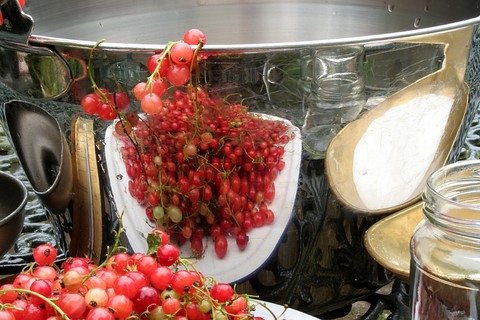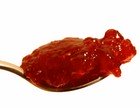Homemade Jelly Recipes and How to Make Jelly with 7 Step-by-Step Instructions

Find easy homemade jelly recipes and instructions on how to make jelly for apples, grapes, blackberries, mint, raspberries and rose hips, to name just a few.
HOW TO MAKE JELLY AND THE BASIC PROCEDURE
1. Prepare the fruit by washing and discarding any fruit that has spoiled. Do not peel, core or stone the fruit. Cut up larger fruit.
2. Cook the fruit slowly with enough water to almost cover it. Fruit should never float in the pan. Simmer for at least 45 minutes and should be very soft. Extra water can be added, if necessary to prevent burning.
3. Put the pulp into the scalded jelly bag and strain the juices into a bowl.
4. The average rule of thumb, when not taking into account of any modifications, each quantity of fruit should yield 4 cups of juice, to which you would add 3 1/2 cups of sugar. However, one needs to test for pectin content and work out the amount of sugar needed as described above to make sure your jelly sets. If there is more than 4 cups of juice, reduce it by boiling.
5. Bring the juice to the boil, remove from the heat and add the sugar. Stir until dissolved. Boil again until the setting point is reached. Use the plate setting test, as for jam making above.
6. Before putting into the hot, sterilized jars, skim off any surface scum. Work quickly and remove any excess scum with a dampened paper towel.
7. Pour the jelly into the jars slowly and steadily to prevent bubbles from forming. Cover with lids tightly making sure the jars are well-sealed.
Now that you know how to make jelly we have given you a number of our best jelly recipes to try out.APPLE JELLY RECIPE
1.25 kg of red apples1 teaspoon citric or tartaric acid
Follow the Basic Procedure to make the above jelly.
BLACKBERRY JELLY RECIPE
1.25 kg of blackberriesFollow the Basic Procedure to make the above jelly.
BOYSENBERRY JELLY RECIPE
1.25 kg of boysenberries
Follow the Basic Procedure to make the above jelly.
CRABAPPLE JELLY RECIPE
10 cups crabapples, cored and coarsely chopped2 cups water
2 cups vinegar
6 cinnamon sticks
36 whole cloves
Place chopped apples in a kettle of water, vinegar and cinammon sticks and cloves tied in a little bag.
Mix and cook gently until soft, and remove the spice bag.
Separate the juice from the fruit by pouring through a jelly bag. Hang over a pot and let the juice drip out overnight, or for several hours. Don't rush or force the process. Let it drip out in its own time. If you squeeze the bag in any way by being impatient the juice will become cloudy and won't give you a clear jelly.
The next day measure the juice and for each cup of crabapple juice add 3/4 cup sugar.
Cook to the jelling point, stirring often.
Pour into hot sterlized jars and seal.
ELDERBERRY JELLY RECIPE
3 pounds elderberries1 lemon
1 packaged powdered pectin
4 1/2 cup sugar
Clean and sort the elderberries.
Heat over a low heat, adding just enough water to keep the fruit from burning, until the juices begin to flow. Simmer slowly for 15 minutes.
Pour through a jelly bag and let it drain overnight. Remember for a clear jelly you are not to force the liquid out of the bag.
In the morning measure out 3 cups of the juice. Add the lemon juice and the pectin. Bring to the boil.
Add 4 1/2 cups sugar and boil for 1 minute only, stirring constantly.
Remove from the heat and skim off any foam. Pour into hot sterilized jars and seal.
GRAPE JELLY RECIPE
1.25 kg of grapesFollow the Basic Procedure to make the above jelly.
MINT JELLY RECIPE
1.5 kg green cooking apples (eg: Granny Smith)3 tablespoons white wine vinegar
3 stalks of fresh mint
green food coloring
equal quantities of brown and white sugar
1/3 cup chopped mint leaves
1. Wash and cut up the apples and place them in a large pot. Add vinegar and 3 stalks of fresh mint. Add enough water to almost cover the fruit and simmer for 45 minutes until fruit is a soft pulp.
2. Strain the pulp through the scalded muslin bag.
3. Measure the juice and weigh 400 g sugar for each 500 ml of juice. Bring the juice to the boil, remove from the heat and stir in the sugar to dissolve.
4. Boil the juice and sugar together. When setting point is reached, skim the jelly and add the chopped mint with a few drops of the green food coloring.
5. Pour carefully into jars and make sure that the bottles are tightly sealed.
POMEGRANATE JELLY
4 cups pomegranate juice7 1/2 cups sugar
3 tablespoons lemon juice
1 bottle liquid pectin
Either juice your pomegranates or buy pomegranate juice. I prefer to buy my juice in because of the mess you get with juicing your own. It really isn't worth the trouble and effort. However, if you are hell-bent on juicing your own you can do so using an electric orange juicer to squeeze the individual halves.
Mix the pomegranate juice with the sugar and lemon juice in a large saucepan. Bring to a boil and immediately add the liquid pectin. Boil rapidly for 30 seconds, stirring constantly.
Remove from heat, skim and pour quickly into eleven 8-ounce sterilized jars and seal.
RASPBERRY JELLY
1.25 kg of raspberriesFollow the Basic Procedure to make the above jelly.
ROSE HIP JELLY
1.5 kg rose hipslemon juice
sugar
Place rose hips in a large pan with just enough water to cover. Simmer until hips are soft.
Mash with a wooden spoon and place in a muslin bag to drip. This jelly can be left to drip over night.
For every 600 ml of juice add the juice of one lemon and 400 g of sugar. Stir to dissolve and then boil to setting point following the rest of the Basic Procedure as above.
HOW TO MAKE JELLY AND GENERAL INSTRUCTIONS FOR PERFECT JELLY MAKING
When making jellies you will, however, have to first make or buy a jelly bag. These should be made only of muslin or cotton sheeting and should be about 50cm x 35cm, sewn on three sides, and left open on a short side. Before adding the fruit the bag should be washed and just before use, scalded by pouring boiling water through it.
The bag should be held high above the bowl to catch the juice. This can be achieved by placing 2 chairs back to back, placing a broom handle across the back, with the jelly bag tied in the middle of the broomstick, with the bowl beneath.
The juice takes about an hour to drain through the bag. If you leave the juice more than a couple of hours the quality of the juice will spoil.
Never hasten the process by trying to squeeze or disturb the bag during the dripping process. If you do, your jelly will be cloudy.
With your jelly recipes when you have a quantity of juice, you can test the pectin quality by using the methylated spirits test, as mentioned for jam making, above.
If the clot that was formed was good, add 275 g sugar for each cup of juice.
If the clot that was formed was average, add 175 g sugar for each cup of juice.
If the clot that was formed was poor, add 140 g sugar for each cup of juice.
Extra Resources on Making Jellies:
USDA Home Canning of Jams and Jellies
VIDEO ON HOW TO MAKE JELLIES FROM
FRUIT
Add your Homemade Jelly Recipes Here!
We have lots of pages where you can contribute to throughout this website, as you can see from the links below. We love hearing from our readers, and hope you will be one of those we hear from too. Please share your homemade jelly recipes here, so that other may enjoy eating them too! Just type in the form below, we will do the rest.
Leave a Comment
Do you have anything that you would like to add after reading this page? We would love to hear your thoughts. If you can add additional information to what has been written here you will be adding value to the website! No need to have any special skills - just type and submit. We will do the rest!
Did you find this page helpful?
Sharing is a way of saying, "Thanks!"









New! Comments
Do you have something of value to add? Leave me a comment in the box below.